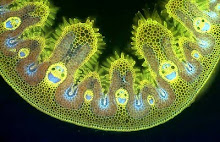All plants are capable of gradual movement as a result of slow growth, but relatively few species can make the kind of rapid movements that we tend to associate with animals. The Venus fly trap Dionaea muscipula and the sensitive plant Mimosa pudica are the two species with rapid leaf movements that are most familiar but another fast-mover is African hemp Sparmannia africana. If you gently brush the cluster of golden stamens in the centre of the flower nothing happens for a second, than they move outwards, away from the stigma. The time delay between the photo above and that of the same flower whose stamens have been brushed, below, is about five seconds and you can easily see how the stamens have spread apart.
Presumably this is some kind of mechanism to aid pollination, although how it would do that isn't obvious. Similar stamen movements occur in Mahonia and Berberis flowers, although in those cases the stamens move rapidly inwards when they are stimulated.
Sparmannia africana comes from South Africa and makes a very fine house plant - if you have room for it. My plant grew too big for our conservatory and is now in Durham University Botanic Garden, where it has reached about three metres in height and is currently flowering and setting seed.


























